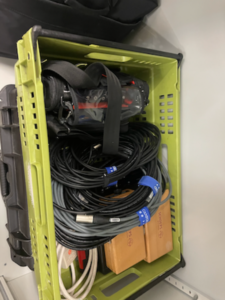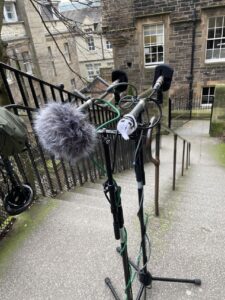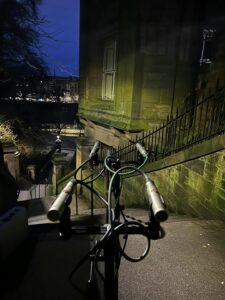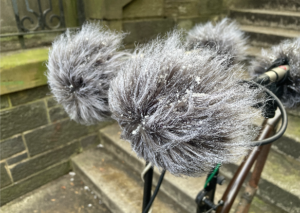Ambient sound, as one of the most intuitive feelings when people are in a “place”, is a very important attribute of the “place” itself. In order to present this property in our installation, we decided to go to the selected location “The News Steps” for field recording to record the ambient sound, edit and process it as one of the elements of the installation sound design, and deliver it to David for sonification in max/msp and to Xiaoqing for interactive sound design.
Because our installation is time-related, we wanted to be able to record the entire day from morning to night, and the duration of the recording would be very long. At the same time, “The News Steps” is a public outdoor space, which poses additional challenges for field recording and requires thorough preparation.

Before making the equipment list, I went to “The News Step” for a site survey. It is a steep and very narrow staircase, but fortunately, there are some small platforms in the middle of the large section of stairs for us to set up the equipment. The pedestrians here are dense and of all ages, so during the recording process, one is to protect the equipment from harm, and the other is to observe the pedestrians’ reactions to the equipment before the formal recording. If they can ignore them and present the most natural way is the best, if they have surprised, curious and funny reactions is also acceptable. The most worrying situation is that people will shut up because they notice the microphones, making the walkers feel disturbed or even offended, which would completely defeat the purpose of recording the daily sound of the place and is something we definitely don’t want to see. If this happens during the test recording, we will reduce the use of microphones that are more familiar to passersby (e.g., shotgun mics). We were initially concerned that such recordings would violate some rights such as the privacy of pedestrians, but since we will do some processing so that the final presentation does not show the original voice or content, so there should be no such risk.
The list of equipment that I have drawn up, taking into account various considerations, can be found in the blog linked below.
https://blogs.ed.ac.uk/dmsp-place23/wp-admin/post.php?post=421&action=edit

After discussing this with the group, we decided to simplify the list to two pairs of condenser mics and a shotgun mic, which was more than enough to represent the ambient sound of the location. In addition to the recording equipment itself, I included batteries, tape, and a large-capacity SD card in the list to prepare for long recording times and various other issues that might arise. Here is the link to the first sound meeting.
https://blogs.ed.ac.uk/dmsp-place23/wp-admin/post.php?post=388&action=edit
We took the equipment to “The News Steps” for a test recording before the formal recording, found the appropriate platform to set up the system, created the work area, smoothly adjusted the equipment and started recording. Two pairs of microphones(Neumann KM184 pair and Shcoeps MK6 pairs) were recorded at fixed locations using the mixpre6II, while the shotgun mic(Sennheiser MKH 416) was recorded using h6 to flexibly roaming around the stairs. The test recording proved to be very necessary. Although we prepared a large number of batteries, the weather was so cold, especially for the mixpre6II, that four brand-new AA batteries would not even last 15 minutes. In addition, since the recording scene was outdoors, the low-frequency noise brought by the wind would be very serious and affect the overall effect if there were no windproof measures. Unfortunately, we had to record the next day and it was too late to use the bookit to borrow some windshields. So we found everything we could use in an emergency to put over the microphone, including a little plush hat that came with the purchase of a drink. Because these things are not so tight for the microphone, I found in the monitoring when the wind is relatively strong, there was the sound of friction between them and the mics. So we used tape to fix them a bit and finally solved the problem. It was a very moving and fun experience for me to see everyone working together to solve a problem. The good news is that the recorded sound was very good and the passersby hardly reacted to the microphone, which made me determined to continue using the shotgun mic.
 After the test recording, I tested it again at home and exported the recording from the SD card to check. Because the mixpre6II’s advance working mode is used, the sound is recorded as poly-wave. Because two pairs of microphones are used, the file has six tracks, the first two tracks are a stereo mix of all microphones, and the last four tracks are separate signals from each of the four microphones. In this way, as long as I recorded the input channel number for each microphone, I could easily tell which microphone was recording the current signal in post-editing. After checking, since our two pairs of microphones were placed back-to-back, the recorded signal did not have phase problems and the mixed signal from the first two tracks could be used directly (provided that the balance of each track was adjusted during recording). There was another unexpected gain in the process: if the recorder was powered through the computer, it would last much longer than four AA batteries. But I couldn’t rule out at the time that it was because the room was warmer, so I still brought an extra H6 recorder as plan b when I was formal recording.
After the test recording, I tested it again at home and exported the recording from the SD card to check. Because the mixpre6II’s advance working mode is used, the sound is recorded as poly-wave. Because two pairs of microphones are used, the file has six tracks, the first two tracks are a stereo mix of all microphones, and the last four tracks are separate signals from each of the four microphones. In this way, as long as I recorded the input channel number for each microphone, I could easily tell which microphone was recording the current signal in post-editing. After checking, since our two pairs of microphones were placed back-to-back, the recorded signal did not have phase problems and the mixed signal from the first two tracks could be used directly (provided that the balance of each track was adjusted during recording). There was another unexpected gain in the process: if the recorder was powered through the computer, it would last much longer than four AA batteries. But I couldn’t rule out at the time that it was because the room was warmer, so I still brought an extra H6 recorder as plan b when I was formal recording.
On the first formal recording day, the group woke up at 5 am and met at “The News Steps” at 6 am to set up the system. (It was really cold!) Because of the experience of the trial recording, the process went very smoothly. The computer was connected to power the recorder and the input channels for each microphone were recorded. Because of problems with the time code inside the recorder, I specifically recorded the duration, start time and end time of each recording. I expected the length of each strip to be ten minutes after editing, so I kept each recording at about 15 minutes. After David’s reminder, I would say the exact time to the microphone at the beginning of each recording, so it would be easier to edit. It was very touching that all the sound design students participated in this field recording with such an early start time and a long duration. The team worked very well together. After setting up the system, some students stayed here to record and monitor, while others helped to buy breakfast. After that, the recording also alternated in turns, with me mainly controlling the mixpre6II and monitoring the two pairs of main microphones, while the other three alternated using the shotgun mic for more flexible recording. In addition to recording the sounds made by pedestrians, they also recorded their own footsteps, the sounds of the environment around the steps, their own chats with passersby, the barking of dogs on the roadside, and other very interesting sounds in preparation for the production of interactive sounds later, all in an orderly manner. As time went on, we also changed the position of the main microphone pairs once, placing them on a higher platform to accommodate the “the higher you go, the later it gets” concept of our installation. Fortunately, the computer’s battery held up until the recording was successfully completed. More photos and details can be found in the blog at the link below.
https://blogs.ed.ac.uk/dmsp-place23/wp-admin/post.php?post=442&action=edit
https://blogs.ed.ac.uk/dmsp-place23/wp-admin/post.php?post=450&action=edit

After that, I started to edit the recorded sound. Since there was still a problem with wind noise in the low end, I did a slight dynamic EQ on it, which solved the problem very effectively. At the same time, I went through the edit from the beginning, cutting out any excessive low-end wind noise and other unwanted sounds, and keeping each strip to exactly 10 minutes (for David’s sonification later). Because the final installation will have a large number of channels, in addition to all mixed together in stereo, I also rendered two pairs of microphones each in stereo and four microphones each in mono, naming them fixedly in the time_microphone_L/R/stereo format for easy handover.
The second recording was for the afternoon to evening period. I borrowed four windshields of the same type to try to avoid the problem of low-frequency wind noise, and thanks to them, they helped us to protect these very delicate microphones from the sudden heavy snowfall. Luckily the snow only lasted for a short while and the rest of the recording was not much different from the first time, as we had previous experience and overall it went very well.


Currently, I have finished editing the field recording and delivered the data to the students in the follow-up session. I have learned a lot and the group has become more familiar and united with each other, which is a very new and wonderful experience for me. Afterwards, I will be working with the sound design team to do follow-up work and working with Allison to see if we can combine Max and Kinect to trigger some sounds through audience movement.
Here are the Google drive link of the edited audio files:
March 03
https://drive.google.com/file/d/1JuxCVSa_C8AAwWZ3-oHS88mH-ewmU5fN/view?usp=share_link
March 07
https://drive.google.com/file/d/13BwTmicp3CXq94gKffz5gaxBcPhxRSFv/view?usp=share_link
If you’re reading this in order, please proceed to the next post: ‘Arduino 1st Stage’.
Chenyu Li

